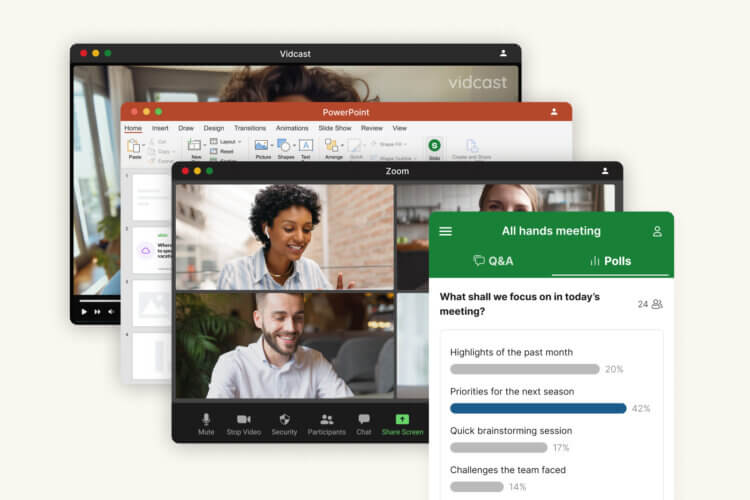Somewhere between 2020-2022, the larger conversation about work evolved.
It pivoted from ‘where I get my work done’ to include ‘when I get my work done’.
In the pre-pandemic days, most of us showed up physically in an office, Monday to Friday, 9 to 5. Work meant being together in person, while taking care of our individual as well as team tasks – in the same place, at the same time.
For decades, employees have had to adjust their lives around work. But in just three years, the tables have turned.
We now know that when given the chance, employees will prioritize flexible schedules and asynchronous work instead. This includes deciding when they work, where they work, and having a say in how they work.
To put some numbers behind this: 47% of people say they are more likely to put family and personal life over work than they were before the pandemic.
But what does this mean for companies? Are leaders expected to ditch offices and cancel all meetings? In this blog, we’re bringing you some answers about the hot topic of asynchronous work and how you can make the most of it.
- Making a case for asynchronous work
- Does asynchronous work even work?
- 3 tips to kick off asynchronous work in your organization
Making a case for asynchronous work
Asynchronous work is here to stay. But, how can we be so sure? The answer is simple. A vast majority of workers demand it.
More than 90% (1) of workers want flexibility around when they work. The agreement on this demand is so unanimous that it will gradually and inevitably become more and more of a standard.
Further, we aren’t together 9-5 anymore. Our work times do overlap, but they don’t do so 100%, as they used to. Especially when we have colleagues from different time zones.
For example, in my remote role at Slido as User Researcher, I’m able to leverage asynchronous work and adjust my own schedule. I’m not expected to deliberate with my manager about taking some time off during the day. Instead, I can take a break, take care of my personal appointments and finish my work later in the evening.
In other words, our work is becoming more and more asynchronous – or async. All we need to do now is to lean into the asynchronous format a little bit more.
But here is a lesser-known fact. Asynchronous work implies greater benefits for companies. A recent series of Future Forum surveys show that employees with time flexibility reported (2):
- 36% greater sense of belonging in their organization
- 50% higher satisfaction with work
- 30% increase in productivity
These are benefits that simply can’t be ignored. Moreover, if individuals are doing better, it means that organizations as a whole are doing better as well.
That’s why companies that allow flexible work timings experience greater talent diversity, talent retention and better business results.

Does asynchronous work even work?
With the Great Resignation still lingering, but starting to trail off, we now find ourselves in the era of a great restructuring, where retaining top talent is of utmost importance.
In this unprecedented phase of work, companies that adopt a global, distributed approach to talent stand to gain more compared to their more traditional counterparts.
For instance, after introducing flexible work, Dropbox (3) started receiving three times the number of applicants than before. Of course, there’s something more foundational behind these positive numbers and the impact of asynchronous work.
The key to making flexible or asynchronous work a success lies in the execution of the overall strategy.
To begin with, the idea of allowing asynchronous work might seem counterintuitive and perhaps even counterproductive to many hybrid or remote working organizations. Advising them to adopt an asynchronous approach, with many employees already feeling disconnected, does feel a bit odd.
However, it’s important to remember it’s not the sum of the hours people spend together that matter, it’s the authenticity of the reason they spend time together when they do.
You may wonder about the relevance of authenticity here.
The need for meaningful time spent at work comes on the heels of some staggering industry statistics from 2022:
- More than 50% of workers feel they have to respond to notifications immediately and are unable to unplug.
- 53% of Gen Z workers say that their days don’t have clear boundaries.
- About 70% say that meetings keep them from working and completing all their tasks.
In another study from the Harvard Business Review, over 92% of surveyed employees referred to meetings as costly and unproductive.
Generally speaking, if you’re caught up in meetings and Slack thread conversations all week, you can’t adjust your schedule too much and hence can only dream of flexibility.
A properly executed asynchronous work can potentially remedy some of these issues, bringing more structure to people’s days as well as cutting down meeting times.
3 tips to kick off asynchronous work in your organization
Initiating a shift to asynchronous work requires a shift in mindset first – for both leaders as well as employees. Let’s take a look at some of the best and recommended practices when it comes to building an asynchronous work strategy.
#1. Adopt a “Fewer meetings, better meetings” policy
One of the most straightforward steps you can take to enable async work is to cut down on the number of meetings you attend in a week. Since meetings are synchronous by definition, not having to attend them gives you more opportunities to work asynchronously.
This trend is continuously on the rise, with Shopify being one of the most recent examples as they canceled the vast majority of internal meetings to rethink their purpose.
Research shows that this direction is a good one to go in. While participating in a one-day-long work experiment without meetings, workers reported:
- 35% increase in productivity
- 48% increase in job satisfaction
- 26% decrease in stress
As you run fewer meetings, you also need to make sure that the ones that take place are really worth it. For that, you need to be truly intentional about the way you meet. Running great meetings is a skill.
To avoid unproductive, over-running, and ill-disciplined meetings, dedicate more time toward creating a meeting agenda and have facilitators in place to keep the conversation on point.
When you decide to run a meeting, ensure participants are engaged and have a voice – it should be a two-way conversation, even with tens or hundreds of attendees. Using tools like Slido can go a long way. Finally, reflect on what works and what doesn’t to shed bad practices and embrace the good ones.
On top of this, with fewer meetings in place, you’ll have room to explore other methods of communication, like asynchronous video messaging using tools such as Vidcast or Loom.
In a recent study by Slido (4), over 90% of meeting organizers told us that at least some of their meetings could be replaced by async videos or presentations.
If you’d like to learn more about implementing asynchronous communication in your company, check out this video.
#2. Acknowledge the complexity of the problem
Moving to asynchronous work isn’t something that will happen overnight. It will require a lot of planning, discussing, and experimenting.
We believe that the most important thing to do is to listen to your employees and see what asynchronous communication means to them and how they imagine it to work.
- Is it about making meetings better documented and searchable?
- Will it help to change the status meetings into video updates but increase the frequency of one-to-one meetings?
- Are your employees better off not having meetings after a certain time or core hours?
You’ll only know once you ask. By running asynchronous surveys using tools like Slido, you can easily collect ideas and suggestions about asynchronous work from your employees.
It’s crucial to remember that one size doesn’t fit all.
You may find that it is almost impossible to create company-wide policies about asynchronous work, which will work for everyone. We also heard this at the World Economic Forum in Davos during a panel on the topic of the future of work.
Each person and each team are different in their work preferences: Are there night owls on the team? Are there people whose time zones don’t overlap too well? Are there people who are at the gym every morning? Whatever is agreed on should match peoples’ needs as much as possible.
Hence, it makes more sense to have a company-wide guideline saying “We want to have fewer meetings” but it will probably make a little less sense to say “Everyone can attend only up to one meeting a week”.
If you stick to the general guidance and let the teams figure out its specifics on the team level, you’re much more likely to succeed.
#3. Experiment with core collaboration hours
One last tip about asynchronous work is, paradoxically, about synchronous work.
No work will ever be 100% asynchronous. Employees will have to inevitably communicate with colleagues in real-time. Be it for scheduled (and properly planned) meetings or if they need an urgent response on something important, like troubleshooting for instance.
That’s why some companies, such as Slack or Dropbox, for instance, established something called “core collaboration hours”. They represent a specific number of hours in a day (usually around four hours) when employees are expected to be around their laptops and available for synchronous communication.
In practice, it can look like this: your company has core collaboration hours between 10 am and 2 pm. Meetings can be scheduled only during this time and if someone texts you in this window, you’re expected to respond in a reasonable amount of time. However, whatever happens before 10am and after 2pm is up to your employees.
The benefit of having core collaboration hours is that your employees can spend dedicated time on deep-focus work knowing that they won’t be distracted. As Melanie Collins (Chief People Officer at Dropbox) says: “The intent of this setup is to encourage non-linear workdays where employees gain more control of their time and have more time for things like deep work.”
If you work with colleagues in other time zones, you might already be used to relying on overlaps.
Over to you
Every shift in the way we work is a challenge and asynchronous work is no exception.
The good news is that technology can make such shifts easier.
By strategically leveraging productivity and collaboration tools, such as Webex, Monday, Slack, Vidcast, Notion, Slido or Asana, you can make your switch to asynchronous work a more manageable one.
To make it work, we recommend one basic tip above all: Be open to experimenting.
Are you a leader looking to adopt an asynchronous method of work in your organization? Get in touch with our experts here.
References
(1) Future Forum Pulse Survey, Winter 2023, p. 10
(2) How the Future Works”, 2022, p. 17, p. 20, p. 109
(3) How the Future Works, 2022, p. 17
(4) Slido Brand Tracker Dec 2022




